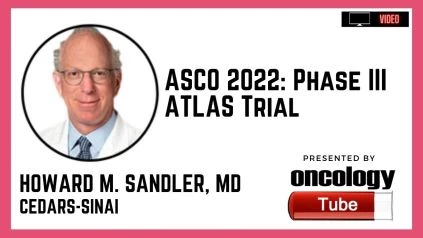Howard M. Sandler, MD, Ronald H. Bloom Family Chair, Cancer Therapeutics, Chair, Department of Radiation Oncology, Professor, Radiation Oncology at Cedars-Sinai. In this video, he speaks about the ASCO 2022 Abstract – Patient (pt) population and radiation therapy (RT) type in the long-term phase 3 double-blind, placebo (PBO)-controlled ATLAS study of apalutamide (APA) added to androgen deprivation therapy (ADT) in high-risk localized or locally advanced prostate cancer (HRLPC).
Origins:
HRLPC is currently managed with long-term ADT and main RT. Despite receiving definitive primary care, these patients face a high risk of metastases and mortality. The phase 3 ATLAS research (NCT02531516) is looking to see if adding APA to neoadjuvant and adjuvant treatment with gonadotropin-releasing hormone agonist (GnRHa) and external beam radiation therapy (EBRT) improves metastasis-free survival (MFS) in high-risk patients. We present (1) the distribution of baseline features in this high-risk patient population and (2) the use of multiple RT regimens for patients with HRLPC that reflect recent worldwide recommendations and clinical practice improvements.
Methodology:
Eligible HRLPC patients (GS 8 or 7 and PSA 20 ng/mL and stage cT2c), with ECOG PS 0/1 and Charlson Comorbidity Index (CCI) 3 are stratified by GS, pelvic nodal status, usage of brachytherapy boost, and area; patients are randomized 1:1 to APA or PBO + GnRHa for 30 (28-d) treatment cycles. For 4 cycles, APA 240 mg/d vs bicalutamide 50 mg/d is used as a neoadjuvant/concurrent treatment to RT; further 26 cycles are finished adjuvantly after RT with APA 240 mg/d vs PBO. MFS (time from randomization to first distant metastasis on CT/MRI/bone scan by independent central review blinded to treatment or death from any cause) is the primary end point. Imaging is performed at baseline and every 6 months from biochemical failure to MFS. PET imaging has been added to the procedure (PSMA, fluciclovine, or choline).
Outcomes:
Pts (N = 1503) were randomly assigned to 266 sites in North America, Latin America, Europe, and Asia. The study is fully enrolled, although it is still ongoing. The overall population had the following baseline characteristics: median age, 67 years; ECOG PS 0/1; 89 percent/11 percent ; tumor categorization at study entry: high-risk, 66 percent /very high–risk, 34 percent ; median PSA, 6.3 ng/mL; cT2, 44 percent /cT3, 50 percent ; cN1, 13 percent. In 90% of ATLAS patients, standard EBRT to the prostate/pelvis was employed over 6-8 weeks (cumulative 78-81 Gy); in 10%, newer hypofractionation plans (per CHHiP or NRG/RTOG 0415) were used (20×3 Gy/d or 28×2.5 Gy/d). EBRT was paired with brachytherapy in 5.6 percent of patients (per ASCENDE-RT).
Observations:
ATLAS research population baseline characteristics represent patients with high- and extremely high-risk features and pelvic nodal involvement having primary RT in clinical practice. The RT regimens used reflect recent research and guideline revisions for hypofractionation use in this patient population. ATLAS is an example of how RT, in combination with next-generation androgen receptor inhibitors, can be included in phase 3 trials of HRLPC (eg, APA). NCT02531516 is the clinical trial number.

